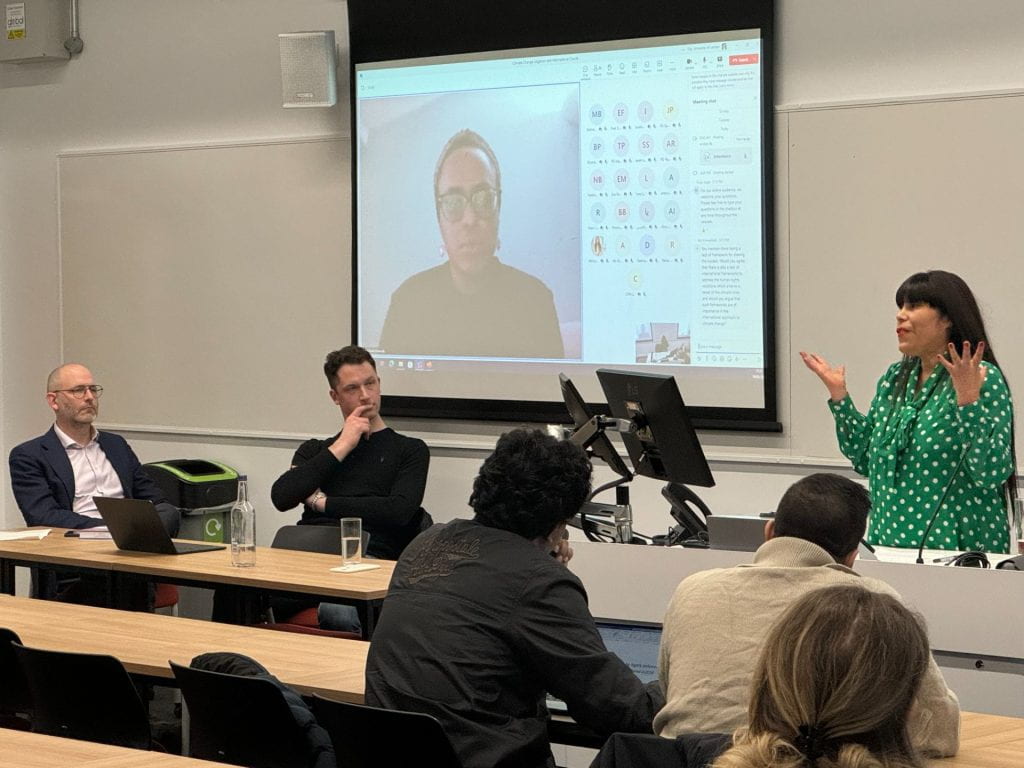By Engin Firat
Recent years have seen rapid and widespread climate changes, driven by human activities, notably greenhouse gas emissions (GHGs), as highlighted in the latest findings from the Intergovernmental Panel on Climate Change (IPCC). With temperatures already surpassing 1.1°C above pre-industrial levels and projections indicating a looming 1.5°C increase, urgent action is imperative to mitigate emissions and adapt to inevitable changes. Despite the severity of this environmental threat, political efforts to tackle GHGs remain insufficient. Litigation has emerged as a notable strategy in recent endeavours to address the climate crisis, underscoring the need for more robust action.
Given the gravity of these sobering realities, the recent event organised by International Law and Affairs Group (ILAG) and the City Sustainability Society, ‘Climate Change Litigation and International Courts’, held on March 14, 2024, and hosted by the City Law School, assumed a heightened significance. Chaired by Dr Jed Odermatt, Reader at the City Law School, the event brought together legal experts from legal practice and academia, including Mr Paul Clark, Barrister at Garden Court Chambers, Ms Monica Feria-Tinta, Barrister at Twenty Essex, and Dr Yusra Suedi, Lecturer at the University of Manchester. Their aim was to scrutinise the role played by international courts in tackling climate change, thereby providing invaluable insights into the nexus of international law, domestic law, policy, and climate urgency.

The event commenced with Mr Clark, who provided a comprehensive discussion on the role of domestic and international courts in addressing climate change. Mr Clark acknowledges both optimism and pessimism in their effectiveness. He begins by highlighting the urgent need for action emphasised by the IPCC’s report, stressing the vital role of domestic courts in enforcing necessary emissions cuts. However, he notes a tendency among domestic courts to sidestep climate-related cases through procedural hurdles, such as standing, causation, and characterising disputes as political, thereby perpetuating the climate crisis.
Mr Clark touches on recent domestic cases, such as Smith v Fonterra in New Zealand and Milieudefensie v Royal Dutch Shell in the Netherlands, illustrating both promising developments and shortcomings in legal reasoning. He also comments on the landmark Urgenda case in the Netherlands, cautioning against minimalistic approaches to emissions reduction targets adopted by some courts. Mr Clark emphasises the critical role of the European Court of Human Rights (ECtHR) in addressing climate change phenomenon advocating for a strategic use of international law within the ECtHR to set precedents that guide domestic courts towards more robust climate action. He highlights the ECtHR’s potential to enforce decisions aligned with the Paris Agreement goals, citing the Duarte Agostinho case, one of three pending cases before the Grand Chamber. As a representative of youth applicants in this case, Mr Clark anticipates the Court’s imminent conclusion, expecting it to contribute to shaping climate litigation outcomes, in seeking to compel governments and domestic courts to adopt deep and urgent emissions cuts necessary to uphold the rights of the applicants and future generations. Through the strategic utilisation of international law, incorporating principles of shared responsibility and evidential methodologies such as the Climate Action Tracker, climate cases can serve as a foundation for international and domestic courts to effectively address the climate emergency. He also emphasises the importance of dialogue between domestic and international courts, envisioning a symbiotic relationship in addressing the climate emergency. Overall, Mr Clark’s analysis underscores the complex interplay between legal frameworks and the urgent need for collective action to mitigate climate change effectively.
In the following discussion on the evolving landscape of international law and climate change litigation, Ms Monica Feria-Tinta highlights the pivotal role of various international legal institutions in addressing climate-related challenges. Drawing from her extensive experience and involvement in landmark cases such as the Torres Strait Islanders case, Ms Feria-Tinta elucidates the intricate journey of utilising international legal frameworks to hold states accountable for their actions or inactions concerning climate change. Ms Feria-Tinta underscores the dynamic nature of international law’s response to emerging global crises.
Ms Feria-Tinta emphasises the critical importance of treaty interpretation and the application of principles such as systemic integration in resolving complex legal disputes related to climate change. Through her analysis, she sheds light on the nuanced approach required to navigate the intersection of various legal instruments and frameworks, from human rights treaties to environmental agreements like the Paris Agreement. By elucidating the significance of precedent-setting cases like the Torres Strait Islanders case, Ms Feria-Tinta underscores the potential of international law to provide effective remedies for climate-related violations, including full reparation for affected communities. Moreover, her discussion of pending advisory opinions before the International Tribunal for the Law of the Sea (ITLOS), Inter-American Court of Human Rights, and the International Court of Justice (ICJ), highlights the crucial questions surrounding transboundary harm, state responsibility, and the right to life in the face of climate-induced threats. She believes that these advisory opinions will play crucial roles in clarifying various aspects related to climate change and human rights and it may influence subsequent decisions by other international mechanisms dealing with similar issues. Additionally, Ms Feria-Tinta notes Australia’s objection to using the Paris Agreement to interpret the obligations under the Covenant (ICCPR), citing differences in the treaty parties. Yet, the UN Human Rights Committee rejected this, endorsing systemic integration in climate cases. Ultimately, Ms Feria-Tinta’s insights highlight the evolving role of international law in addressing the urgent issue of climate change and offer optimism about the increasing receptiveness of courts to leverage legal mechanisms for effective climate action.
In examining the potential for climate litigation within the African human rights system, Dr Yusra Suedi highlights Africa’s unique vulnerability to climate-related harms, shedding light on its potential and challenges. Emphasising the disproportionate impact that climate change will have on the continent in the coming years, she underscores the urgent need for the region to engage in legal discourse on this issue.
Despite Africa’s relatively low contribution to global GHG emissions, exemplified by South Africa’s prominent standing among top emitters, Dr Suedi emphasises the continent’s crucial role in shaping climate litigation discourse. By referring to the Sacchi et al. case, dismissed by the UN Committee on the Rights of the Child, and the pending Duarte Agostinho case before the ECtHR, she navigates through procedural intricacies, such as the exhaustion of domestic remedies and the concept of victimhood, illustrating the path paved by precedents set in international human rights bodies.
Dr Suedi also explores the potential of leveraging the African Court on Human and Peoples’ Rights (ACtHPR) for public interest litigation, highlighting its acceptance of harm collectively and its openness to actio popularis. Furthermore, she discusses the prospect of seeking advisory opinions from the ACtHPR, acknowledging the challenges posed by stringent criteria for NGO recognition. Despite these hurdles, she maintains an optimistic outlook, viewing such legal endeavours as vital steps toward climate compliance and justice. Dr Suedi’s analysis offers a comprehensive overview of the opportunities and obstacles in harnessing the African human rights system for climate litigation, indicating the importance of integrating it into global discussions and providing valuable insights into the challenges and opportunities ahead.
The discussion expanded to encompass the role of international courts in addressing climate change issues, with particular attention to advisory opinions. Dr Suedi highlighted the potential of advisory opinions from bodies like the ICJ and ITLOS to influence major emitters’ obligations, considering the jurisdictional hurdles in contentious cases. Ms Feria-Tinta emphasised the importance of litigation as a strategy to push states towards action, citing a UN statement acknowledging the impact of litigation on state compliance. However, Mr Clark cautioned against overstating the power of litigation, noting the significant role of politics in legal proceedings and the limitations of judicial remedies in addressing complex global challenges. Ms Feria-Tinta echoed the importance of politics in legal contexts, acknowledging the interplay between law and political realities, as evidenced in discussions around systemic integration and judicial decision-making.
These insights reflect the multifaceted nature of climate change litigation and the ongoing effort to navigate legal landscapes in pursuit of rapid and effective solutions. The role of international law is crucial, given its influence on domestic courts and its power to compel compliance. Despite encountering unsuccessful decisions and technical hurdles, each case serves as a milestone and a facilitator for future litigation, providing valuable precedents and insights. While it is essential to recognise that litigation alone cannot be a ‘panacea for all woes,’ it remains a vital tool in the arsenal of international law scholars and practitioners. Furthermore, it is evident that existing principles of international law may be unresponsive and should be reconsidered in the long term to address global crises effectively instead of accommodating political and sovereign hesitations. With our planet facing a formidable threat, leveraging the power of litigation alongside other strategies becomes increasingly imperative.

Leave a Reply